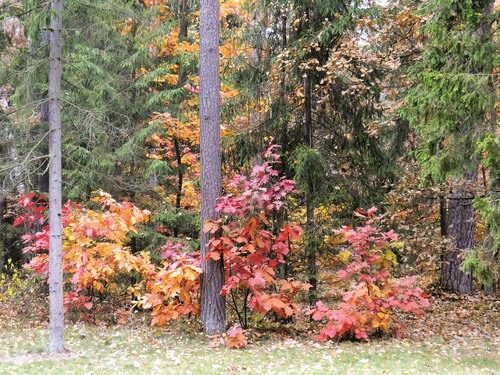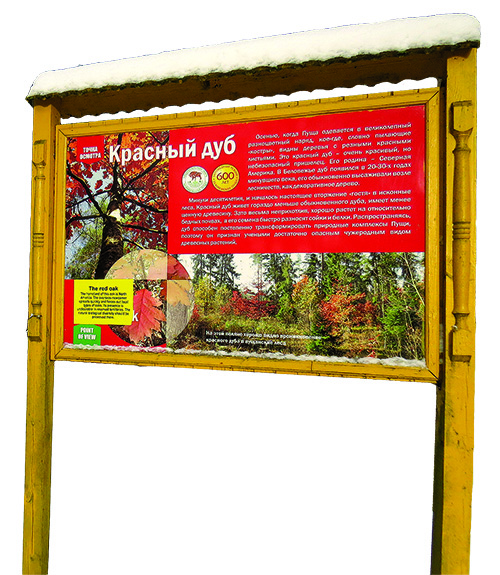Apart from the familiar Red Book, containing rare and endangered species, a Black Book is also planned: Belarusian scientists have prepared an edition describing 54 varieties of aggressive plants. These should be kept under control, and must not be allowed to penetrate nature reserves.

Red oak is alien in Pushcha
The spontaneous growth of 105 varieties of alien shrubs and trees has already been registered in the Belovezhskaya Pushcha. Currently, twenty percent of the national park’s is under the threat of being covered with red oak. This winter, a plan of action against this tree has been launched as well as recent five-year plan of action aimed at destruction of this migrant oak, developed jointly with APB Birdlife under the aegis of the Frankfurt Zoo Society to support the Belovezhskaya Pushcha reserve status.
I’m walking along a park avenue to the administrative building. On frosty winter days, all surrounding trees look the same as they have no leaves. True beauty is observed in the autumn, however. Red oaks are pleasing to the eye. These brightly coloured ‘foreigners’ were introduced to the Pushcha in the early 20th century from the USA. Mainly at the hands of people, but slightly owing to the birds, the area where these trees grow occupies around 1,280 hectares. A senior research officer at the park, Dmitry Bernatsky, believes the threat from this alien variety is high. “In 2004, territory of several forestries joined the park. Many red oak trees grow there, already covering 114 hectares of the reserve. Trees and bushes are cut regularly but we now need to make a decisive step to eliminate seedlings close to forestry offices,” he comments.

Arkady Skuratovich
The national park’s head forester, Vasily Filimonov, has no doubts: the fight against red oaks will not be easy. “The hardest task is to persuade people of the danger. These ‘foreigners’ really do create a threat for the park as it pushes back our Belarusian varieties: penduculate and sessile oaks (the latter is in the Red Book).” A famous Belarusian botanist and Candidate of Biological Sciences, Arkady Skuratovich, explains that, in the past, imported varieties of tree were much more modest. “Since the 1950s, we have registered foreign plants regularly,” he says. “However, this was not an issue as the plants were much more modest. Nature and the climate are changing however, the cold zone has receded and the moderate zone has reached Vitebsk. As a result, sun loving plants are spreading; in the 20th century, these only grew in the south of the country.”
Alien trees come to us in different ways. Some are brought by rivers and plants and others are transported by people. Mr. Skuratovich speaks of two examples of unintentional introduction of plants. Firstly, seeds come in with wool. A wool processing facility operates in Ilyich, in the Rogachev District. So far, 15 varieties of plants have come to Belarus in raw materials from Australia and New Zealand. Two of them have spent the winter season successfully and are already ‘mastering’ territory near a waste treatment works on the Dnieper River bank. Secondly, seeds arrive with cranberries. The Zhuravinka experimental base operates in the Gantsevichi District. With large cranberries, 24 varieties of weed have penetrated Belarus; seven of them have run out of control. According to the scientist, it’s possible to avoid this kind of invasion. It’s necessary to utilise waste rather than throw it away — like dacha owners do. Belaruskie Zhuraviny company (in the Pinsk District) destroys all waste and the situation there is under control, compared to their colleagues in the Gantsevichi region.

Information board on alien oak installed in national park
Goldenrod has grown wild from dachas and cemeteries, while cow parsley has now spread due to scientists who tried to grow cheap forage for cattle. Red oak has been brought in intentionally to beautify our forests. In addition, foresters cultivated black cherry for its timber. Green broom was brought as a feed for hare while silkweed was once a strategic plant for the light industry (at present, it’s a serious weed). Interestingly, we view chokeberry, mespilus and sandthorn as our native plants, these once came from abroad and are now ‘conquering’ the forests of the Brest Region aggressively. It’s impossible to name all foreign plants as evil. The potato was brought to our country in the 18th century and is now an integral part of the national cuisine. Mr. Skuratovich believes the situation needs to be kept under control. “I think you’d agree: the national park should contain our national plants rather than Northern American. With this in mind, it’s no place here for red oak and goldenrod,” he says. Sometimes plants damage not only the environment but also human health. Everyone has heard of cow parsley but few are aware of the threat of tickseed. Mr. Skuratovich comments that many pharmacies sell American tickseed rather than Belarusian; it generates no healing effect (fortunately, it also causes no damage).
Belarusians are true humanists, getting rid of ‘foreign’ plants carefully. According to Mr. Skuratovich, Northern Americans treat ‘imported’ plants very aggressively. “They simply destroy them by burning them down or using herbicides. Several years later, they re-cultivate the land to seed their own plants.”
At present, there are over 300 plants acknowledged as migrants to Belarus, with 54 of the most aggressive contained in the Black Book (ready for publishing). Since 2015, Belpochta has released a series of stamps — Invasive Plants of Belarus; goldenrod and cow parsnip were printed first. We need to be well aware of our green enemy.
By Valentina Kozlovich











